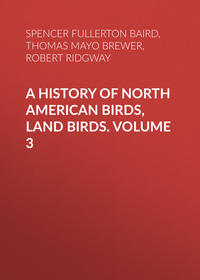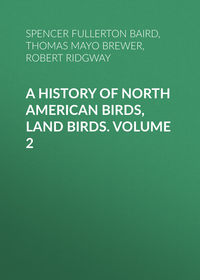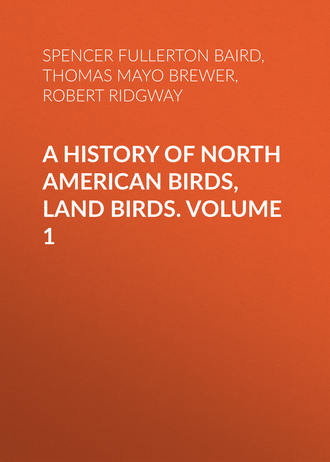 полная версия
полная версияA History of North American Birds, Land Birds. Volume 1
Young birds (as in 1,120) differ in a tinge of reddish-fulvous on the upper parts; the wing-coverts, secondaries, and inner primaries margined more or less broadly with a brighter shade of the same. The gray of the under parts is also washed with this color, especially on the chin and across the breast. The hooks of the edge of the wing have not yet become developed.
(No. 32,269 ♂, fresh specimen before being skinned.) Total length, 5.40; expanse of wings, 12.20; wing from carpal joint, 4.50.
(No. 32,269 ♂, prepared specimen.) Total length, 5.20; wing, 4.50; tail, 2.25, depth of fork, .15; difference of primaries, 2.28; length of bill from forehead, .40, from nostril, .24, along gape, .56, width of gape, .43; tarsus, .45; middle toe and claw, .57; claw alone, .19; hind toe and claw, .41; claw alone, .16.
Hab. Whole United States (exclusive of Northeastern States?) south to Central Mexico.
Habits. The Rough-winged Swallow was first met with by Audubon, in Louisiana, but described by him from specimens afterwards procured near Charleston, S. C. He knew nothing in regard to its habits, and its distribution was equally unknown to him. It has since been found, but nowhere very abundantly, in various parts of the United States. It has not been met with on the Atlantic coast farther to the north than New Jersey and Pennsylvania. On the Pacific coast it is more common. Dr. Suckley speaks of it as quite abundant both in Oregon and in Washington Territory. Dr. Cooper, in his Zoölogy of Washington Territory, speaks of it as common about the sandy cliffs of the bays and inlets of that coast, arriving near the Columbia in May, and remaining only until the middle of August, when all these Swallows go southwards, though their last brood is hardly able to fly. He says that they burrow holes in the soft sandy banks near the tops of cliffs, and have generally the same habits as the common Bank Swallow. They have no song, only a few chirping calls.
Dr. Cooper, in his Report on the birds of California, further states that this Swallow, in summer, is found throughout the lower portions of that State. He saw them at Fort Mojave as early as the 27th of February, and as he has met with them at San Diego in November, and also in January, he thinks they may winter within the State. He describes their burrows in the sandy banks of rivers as being to the depth of three feet, crowded very near together, and near the upper edge of the bank, in no wise different from the nesting of the common C. riparia. The nests are composed chiefly of dry grasses, with a few feathers, and contain five white eggs. Occasionally, however, they resort to natural clefts in the bank or in buildings, and to knotholes in trees. In the fall they congregate in great numbers about certain favorite spots, and keep much together in flocks. At night they roost in their burrows. In Arizona, according to Dr. Coues, they are summer residents, breeding abundantly, arriving late in April and remaining until nearly the last of September.
At Eagle Pass, Mr. Dresser met these birds, arriving from the South, on the 21st of February. There, and also at San Antonio, they were very common, breeding in the towns, making their nests under the eaves and in holes in the old walls, depositing their eggs by the 25th of April. Dr. Kennerly also found this Swallow very abundant along the Colorado River in February. Its flight seemed to him to be like that of the common Barn Swallow. Dr. Heermann frequently met with this species during the journey from the junction of the Gila and Colorado Rivers through Mexico, New Mexico, and Texas, to San Antonio. In the latter place he found them breeding almost entirely in crevices in the walls of houses.
In the vicinity of Washington, Dr. Coues found this Swallow a summer resident, but rather rare, arriving in the third week of April, and leaving about the middle of September.
Mr. Ridgway speaks of this bird as one of the most abundant Swallows of the West, inhabiting the river valleys, and breeding in holes in the banks of the rivers. He says that in Southern Illinois it is much more abundant than the C. riparia, though both nest in the same banks.
This species was first found breeding in Carlisle, Penn., by Professor Baird, in the summer of 1843. The following year I visited this locality early in June, and had an opportunity to study its habits during its breeding-season. We found the bird rather common, and examined a number of their nests. None that we met with were in places that had been excavated by the birds, although the previous season several had been found that had apparently been excavated in banks in the same manner with the Bank Swallow. All the nests (seven in number) that we then met with were in situations accidentally adapted to their need, and all were directly over running water. Some were constructed in crevices between the stones in the walls and arches of bridges. In several instances the nests were but little above the surface of the stream. In one, the first laying had been flooded, and the eggs chilled. The birds had constructed another nest above the first one, in which were six fresh eggs, as many as in the other. One nest had been built between the stones of the wall that formed one of the sides of the flume of a mill. Two feet above it was a frequented footpath, and, at the same distance below, the water of the mill-stream. Another nest was between the boards of a small building in which revolved a water-wheel. The entrance to it was through a knot-hole in the outer partition, and the nest rested on a small rafter between the outer and the inner boardings.
The nests were similar in their construction to those of the Bank Swallow, composed of dry grasses, straws, and leaves, and lined with a few feathers; but a much greater amount of material was made use of, owing, perhaps, to the exposed positions in which they were built.
The eggs, six in number, in every instance that we noticed, were pure white, about the size of those of the riparia, but a little more uniformly oblong in shape and pointed at one end. Their length varies from .78 to .69 of an inch, the average being .75. Their average breadth is .53 of an inch.
Genus COTYLE, BoieCotyle, Boie, Isis, 1822, 550. (Type, Hirundo riparia, L.)
Gen. Char. Bill small; nostrils lateral, overhung by a straight-edged membrane. Tarsus about equal to middle toe without claw; feathered at upper end, especially on inner face, and having also a small tuft of feathers attached to posterior edge near the hind toe. Middle toe with basal joint adherent externally to near the end, half-way internally, the claws comparatively little curved, the lateral reaching beyond the base of the middle. Tail slightly forked. Color dull lustreless brown above, in riparia white beneath with gray pectoral band. Nests in holes in banks; eggs white.
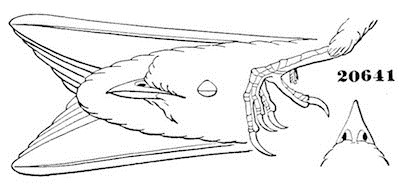
Cotyle riparia.
20641
Many American birds have been referred to Cotyle, but the only one really belonging to the genus is the cosmopolitan C. riparia. The peculiarity of the genus consists essentially in the tuft of tarsal feathers at the base of the hind toe, and the unusual length of the lateral claws, combined with the lateral nostrils overhung by membrane. By these characters the genus is very easily distinguished from Stelgidopteryx.
Cotyle riparia, BoieBANK SWALLOW; SAND MARTINHirundo riparia, Linn. S. N. I, 1766, 344.—Wils.; Aud.—Lembeye, Aves de Cuba, 1850, 47, lam. vii, fig. 3.—Jones, Nat. Hist. Bermuda, 34 (occasional, Aug. and Sept.). Cotyle riparia, Boie, Isis, 1822, 550.—Cassin.—Brewer, N. A. Oöl. I, 1857, 105, pl. iv, fig. 49 (eggs).—Cab. Jour. 1856, 4 (Cuba).—Baird, Birds N. Am. 1858, 313; Rev. 1864, 319.—Ib. 1861, 93 (Costa Rica [?]).—Gundlach, Cab. Jour. 1861, 330 (very rare in Cuba).—March, Pr. A. N. Sc. 1863, 297 (Jamaica; very rare). Heermann, P. R. R. X, 36 (California; abundant?).—Dall & Bannister, 280 (Alaska).—Cooper, Orn. Cal. 1, 1870, 110.—Samuels, 258. Hirundo cinerea, Vieill. Hirundo riparia americana, Max.
Sp. Char. Adult. Above grayish-brown, somewhat fuliginous, with a tendency to paler margins of the feathers. Beneath pure white, with a band across the breast and the sides of the body like the back. Length, 4.75; wing, 4.00; tail, 2.00.
Young birds have less emarginate tails, and the feathers of back, rump, and wings edged with whitish.
Hab. The whole of North America; Bermudas; Greater Antilles; Costa Rica; Western Brazil (Pelz.). Also found in the northern parts of the Old World.
A critical examination has failed to reveal any difference between European and American specimens of this bird.

Cotyle riparia.
Habits. The common Bank Swallow as we know it, or Sand Martin as it is called in England, is nearly or quite cosmopolitan in its distribution. Found throughout Europe in the season of reproduction, and in portions of Africa in the winter months, it is equally common throughout North America in the summer, and probably winters in Mexico and in Central and South America, though it is not mentioned by Sumichrast as a bird of Vera Cruz. It is said to occur in various parts of the continent of Africa, and in Europe it extends its migrations to the extreme northern regions. It has also been met with in India and in Siberia. Mr. Salvin obtained several specimens at Duenas, Guatemala, in September, 1861, having previously observed it about the Lake of Yzabah.
On both continents it is somewhat local in its distribution, in favorable localities being quite abundant, and in others not known to exist. It is an early spring visitant wherever found, appearing in England by the 24th of March, and even in our high Arctic regions early in May, often in such inclement weather that it is obliged to take refuge in holes. Mr. Dall met with this species in Alaska, in favorable situations, in immense numbers. He counted on the face of one sand-bluff over seven hundred nest-holes made by these birds, and all of them apparently occupied, so that the bluff presented the appearance of an immense honeycomb alive with bees. He states that it takes the bird four days to excavate its nest. Rev. F. O. Morris, on the other hand, who has closely watched their operations in England, says that it requires a fortnight, and that the weight of sand a pair of these birds removes is twenty ounces in a day. Pebbles of more than two ounces in weight have been known to be taken out by them.
The flight of this species is rapid, but unsteady and flickering. In searching for their food they skim low over the surface of both land and water, dropping upon the latter, as they fly, to drink or to bathe. Their food consists of the smaller kinds of winged insects, which they pursue and capture, dashing at them at times even on the water. They usually feed their young with larger kinds than they eat themselves.
It has not been observed in Greenland, but Richardson found it in colonies of thousands at the mouth of Mackenzie’s River, in the 68th parallel. It is a very social bird, usually breeding together in large communities, and is more independent of man than most of its family, owing him no other favors than those incident to excavations through sand-banks, of which it avails itself. The nests of these Swallows are placed in excavations made by them in the banks of rivers, cliffs by the sea-shore, and similar favorable situations. These are usually as near the surface of the ground as the nature of the soil permits to be readily penetrated, though the bird has been known to work its way even through hard gravel. Their depth varies from fourteen inches to four feet, though two feet is the usual distance.
Mr. Augustus Fowler mentions a remarkable instance of sagacity and provident forethought in these birds, not easily separable from reason. In the town of Beverly, in a stratum of sandy loam, he observed each season a colony of some twenty or thirty pairs of these birds. In this place these birds never burrowed more than two or three feet. Within a mile of this place another colony excavated a bank in which the layer of loam was mixed with small stones. In this bank they excavated to the depth of five, seven, and even nine feet. Why was there this extraordinary difference in the length of burrows made by the same species, in situations not more than a mile apart? The reason for this difference, upon examination, became very obvious. We give the explanation in Mr. Fowler’s own words: “In one bank, where the earth was of a fine sandy loam, easily perforated, from the entrance to the extremity the burrows did not exceed three feet in length; while in the other bank, with harder loam to work in, one burrow was found nine feet in length. After examining six holes of nearly equal length, it appeared that these little birds had sufficient reason for extending their labors so far into the earth. In every instance, where they met with a spot free from stones they finished their burrows; thus showing great care for the welfare of their eggs or young by avoiding, in the stony soil, a catastrophe so great as would befall their treasures if by accident one of these stones should fall upon them.”
The work of perforation they perform with their closed bill, swaying the body round on the feet, beginning at the centre and working outwards. This long and often winding gallery gradually expands into a small spherical apartment, on the floor of which they form a rude nest of straw and feathers. The time occupied in making these excavations varies greatly with the nature of the soil, from four or five days to twice that number.
Their eggs are five in number, pure white, and when unblown have a fine roseate hue. They are oval in shape, larger at one end, and pointed at the smaller. Their average length is .72 of an inch, and their average breadth .47.
We now come to the consideration of three families of Oscine birds, of pre-eminently dentirostral type, having certain common characters by which they are distinguishable, with but little difficulty, from all others. In their close relationship it has been questioned by many whether they do not all belong under one head, but they are more generally considered distinct. The common characters, and those peculiar to each, are as follows:—
Common Characters. Bill stout, and considerably hooked at tip, or with the point bent abruptly downward; with a deep notch, and sometimes a tooth or lobe just behind the notch; the tip of the lower mandible likewise frequently bent up, and with a notch behind it. The nostrils lateral, the bristles of the mouth generally well developed. The primaries are ten (except in a few Vireos), the outer from one fourth to one half the second. Tail variable. Tarsi scutellate anteriorly; sometimes with a tendency to division on the lateral plates; hitherto not met with. Basal joints of toes more adherent. Separated from Turdidæ by greater adhesion of toes; from Troglodytidæ by notched and hooked bill, etc.
A. Basal phalanx of anterior toes abbreviated; that of median toe decidedly shorter than the basal of inner, or the two basal of outer, and adherent for its whole length on both sides to the lateral (i. e. not free at all). Lateral plates of tarsus undivided, except at extreme lower end.
Vireonidæ. Gonys more than half the length of lower jaw (from tip to angle of mouth), usually longer than width of mouth, which is narrow. Bill conical, much compressed, decurved at end and notched, but scarcely toothed. Frontal feathers bristly and erect, or bent but slightly forward. Nostrils overhung by membrane. Tarsus longer than middle toe and claw. Lateral toes generally unequal; outer claw reaching half-way along middle claw.
B. Basal phalanx of middle toe about as long as the basal of inner, or the two basal of outer; free externally, at least for about one third its length, internally for about one half. Lateral plates of tarsus with decided tendency to subdivision (except in Myiadestinæ).
Ampelidæ. Gonys decidedly less than half the length of lower jaw, or than width of mouth, which is very broad and deeply cleft. Bill triangular, much depressed, decurved at end and notched, with moderate though decided tooth. Frontal feathers rather soft, scarcely bristly or erect. Nostrils overhung by membrane. Tarsus equal to or shorter than middle toe and claw. Lateral toes nearly equal; outer claw reaching only to base of middle claw.
Laniidæ. Gonys about half the length of lower jaw; about equal to width of mouth. Bill very powerful and raptorial, much compressed, with a strongly marked hook, notch, and tooth at end. Frontal feathers very bristly, and directed forwards, so as to conceal nostrils and base of bill. Nostrils with bony walls, except behind. Tarsus longer than middle toe and claw, sometimes much scutellate on sides. Lateral claws nearly equal; outer claw reaching a little beyond base of middle claw.
Family VIREONIDÆ.—The Vireos
The essential features of this family appear to consist in the combination of the dentirostral bill, notched in both mandibles; the ten primaries (except Vireosylvia), of which the outer is usually from one fourth to one half the second; the rather short, nearly even tail, with narrow feathers, and the great amount of adhesion of the anterior toes,—the whole basal joint of the middle being generally united on both sides to the adjacent joints, and decidedly shorter than the basal of inner or two basal of outer. The outer lateral toe is generally appreciably longer than the inner, reaching considerably beyond the base of the middle claw. The tarsi are always distinctly scutellate anteriorly. The young are never spotted, or streaked as in the Thrushes; nor, indeed, do the adults exhibit such markings.
The Vireonidæ are peculiar to the New World, and are widely distributed, although but one genus belongs to the United States.
Genus VIREO, VieillVireo, Vieill. Ois. Am. Sept. I, 1807, 83. (Type, Muscicapa noveboracensis, Gm.)
No great violence will be done by considering all the American Vireos as belonging to one genus, divisible into three subgenera, as, however different the extremes of the series may be from each other, the gradation is quite complete.
The North American species take a wide range during their southern winter migration, only paralleled in this respect by the Sylvicolidæ; they do not visit the West Indies, save as very rare stragglers to Cuba (V. olivaceus, solitarius, flavifrons, and noveboracensis). They all have a melodious song, and, so far as known, make a deep nest, suspended by its upper edge between the forks of a horizontal twig. The eggs are white, generally with a few reddish or brown blotches.
Quite a number are characterized by having the eyes white, red, or yellow.
SubgeneraVireosylvia. Bill compressed, narrow; culmen and commissure straight, the tip abruptly curved (or, if this is not the case, there is no trace of light bands on the wing; see section “b”). Superciliary stripe continued back to the occiput. No trace of light bands on the wing. No conspicuous ring round the eye.
a. No spurious primary. Bill compressed, its tip abruptly hooked; culmen and commissure straight. Crown decidedly more ashy than the back … Sp. flavoviridis, barbatulus, olivaceus, philadelphicus.
b. An acute spurious primary. Bill depressed, the tip only slightly hooked; culmen slightly curved. Crown scarcely more ashy than back … Sp. gilvus.
Lanivireo. Bill compressed, stout; culmen arched from the base, commissure curved. Superciliary stripe stopping at posterior angle of the eye and curving under it, enclosing the eye in a conspicuous orbital ring, interrupted only in front. Two conspicuous white bands on the wing.
a. No spurious primary … Sp. flavifrons.
b. With an acute spurious primary … Sp. solitarius, plumbeus.
Vireo. Bill stout, scarcely compressed, sub-cylindrical. First primary not spurious, or, if so, not acute.
a. Two conspicuous light bands on wing … Sp. atricapillus, noveboracensis, huttoni.
b. One distinct light band on wing, and this not sharply defined, the anterior one being almost obsolete … Sp. belli, pusillus, vicinior.
Subgenus VIREOSYLVIA, BonVireosylvia, Bon. Geog. Comp. List, 1838. (Type, Muscicapa olivacea, Lin.)
Phyllomanes, Cab. Arch. 1847, I, 321. (No type mentioned; name proposed as substitute for Vireosylvia.)
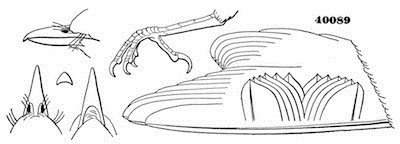
Vireo olivaceus.
40089
Gen. Char. Wings long and pointed, one third or one fourth longer than the nearly even or slightly rounded tail. First quill very small (less than one third the second), sometimes apparently wanting. Second quill longer than the seventh, much longer than the secondaries. Tarsi short (scarcely exceeding .70 of an inch); toes rather long. Body slender and elongated. Bill slender, narrow, straight; the culmen straight for its basal half, the commissure quite straight; light horn-color, paler beneath. Feet weak. Type, V. olivaceus.
Species and VarietiesCommon Characters. All species olive above, white or yellowish beneath. An ashy or brownish cap, contrasting more or less abruptly with the olive back. A whitish superciliary stripe extending to the nape, and a dusky one to and behind the eye. No light bands on the coverts. Inside of wings (flanks sometimes) and crissum yellowish, otherwise usually white beneath.
No spurious primary Series I.
A spurious primary Series II.
Series I. (No spurious primary.)A. A dusky “mustache” or cheek stripe along each side of the throat.
1. V. calidris. Eyes red?
a. No distinct dusky line along side of the crown.
Light stripes of the head dingy brownish-buff; crown scarcely ashy; back olive-brown; crissum and lining of the wing pure pale yellow. Wing, 3.20; tail, 2.25; bill, .42. Hab. Jamaica; Santo Domingo, Porto Rico, Santa Cruz, St. Thomas, and Sombrero. … var. calidris.70
Light stripes of the head dingy grayish-white; crown distinctly ashy; back grayish-olive; crissum and lining of the wing scarcely yellow. Wing, 3.20; tail, 2.35; bill, .42. Hab. Cuba, Bahamas, and South Florida … var. barbatulus.
b. A distinct dusky line along each side of crown.
Colors as in barbatula, but “mustache” broader and more conspicuous, and crown much purer ash. Wing, 3.30; tail, 2.50; bill, .48. Hab. Barbadoes … var. barbadense.71
B. No “mustache.”
a. A dusky line along each side of crown.
2. V. olivaceus. Grayish olive-green above; beneath white, tinged laterally with dull olive; crissum and lining of wing scarcely yellow; inner edges of quills white. Eyes red.
1. Wing, 3.30; tail, 2.40; bill, .38. Hab. Eastern Province of North America, south to Northern South America … var. olivaceus.
2. Wing, 2.50; tail, 1.80; bill, .33. Hab. Eastern South America. … var. chivi.72
3. V. flavoviridis. Yellowish olive-green above; beneath white medially, bright greenish olive-yellow laterally; crissum, lining of wings, and inner edges of quills, light yellow. Eyes yellow.
1. Wing, 3.15; tail, 2.55; bill, .41. Hab. Middle America north of Panama … var. flavoviridis.
2. Wing, 2.80; tail, 2.25; bill, .36. Hab. South America, from Buenos Ayres northward; Guatemala … var. agilis.73
b. No dusky line on side of crown.
4. V. magister.74 Large. Above sooty-olive, more virescent posteriorly; crown without ashy tinge. Beneath similar, but lighter, whitish medially. Crissum and lining of wing very faintly yellow; inner edges of quills white. Eyes? Wing, 3.05; tail, 2.40; bill, .45. Hab. Honduras (Belize).




